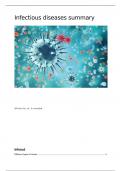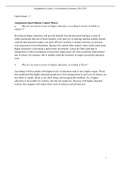Comparative Anatomy and Physiology of Animals
Lecture 13 Adaptations to Hot Environments 01/12/20
Deserts and other hot dry environments
- Affect animals in a variety of ways.
- Temperature- need to respond to extremes, may be seasonal.
- Water availability – need to be able to respond to low or intermittent water availability.
- Need to consider species that live in hot dry environments.
- Also- those species forced to endure hot, exposed environments.
Heat shock proteins
- Heat shock proteins (HPS)- family of proteins that are produced by cells in response to
exposure to physiologically stressful conditions, such as temperature, UV light, and during
wound healing.
- Perform chaperone function by stabilising new proteins to ensure correct folding or by
helping to refold proteins that were damaged by the cell stress.
Responses of fishes to extreme temperatures
Annual killifish (Austrofundulus limnaeus)
- Inhabits isolated ephemeral pools in northern South America
- The daily temperature ranges 20 degrees Celsius, with a maximum recorded temperature of
40 degrees.
- they produce heat shock proteins Hsp70 and Hsp90, which maintain the integrity of cellular
membranes.
- Fish which were exposed to cycling temperature changes use lower molecular weight
chaperones – high-mobility B1 protein (HMGB1) – to stabilise the cell’s DNA to optimise
transcription by counteracting the formation of covalent bonds. This stabilises the
biochemistry of the cells and minimises the overall effect of the cycling temperatures.
Long-jawed goby (Gillichthys mirabilis)
- In an experiment, there were populations of the fish acclimated to 9, 19 and 28 degrees
Celsius, and these fish were exposed to increased temperatures.
- The temperature they were acclimated to seemed to influence the need for particular gene
expression, up until extreme temperatures were reached.
- Mild stress caused by the increase always saw Hsp70 upregulated.
- Higher temperatures stimulated the production of ubiquitin.
- Only under extreme stress was CDKN1B upregulated. This is the protein associated with
apoptosis.
Responses of amphibians in hot, dry conditions
- Amphibians lose water freely through cutaneous evaporation. This is because they are
adapted to highly humid environments and have limited tolerance of high temperatures.
- They cannot produce hypertonic urine (concentrated).
- Instead, they have several ways to cope with the heat.
- Diurnal retreat- desert frogs dig burrows, find hollows (fossorial), or go under tree bark
(scansorial) to avoid extremes of daytime temperatures and desiccation. A lot of desert frogs
exhibit nocturnal behaviour. Very extreme conditions lead to seasonal aestivation (extended
periods of dormancy), e.g. Cyclorana can survive 5 years underground, but usually emerges
with annual rainfall.
- Aestivation- change in physiology often in relation to high temperatures. Many frogs that do
this often create cocoons from their shed skin, which allows them to minimise water loss in
the burrow. The type of soil is very important: sandy soils are easy to manage, but increase
Lecture 13 Adaptations to Hot Environments 01/12/20
Deserts and other hot dry environments
- Affect animals in a variety of ways.
- Temperature- need to respond to extremes, may be seasonal.
- Water availability – need to be able to respond to low or intermittent water availability.
- Need to consider species that live in hot dry environments.
- Also- those species forced to endure hot, exposed environments.
Heat shock proteins
- Heat shock proteins (HPS)- family of proteins that are produced by cells in response to
exposure to physiologically stressful conditions, such as temperature, UV light, and during
wound healing.
- Perform chaperone function by stabilising new proteins to ensure correct folding or by
helping to refold proteins that were damaged by the cell stress.
Responses of fishes to extreme temperatures
Annual killifish (Austrofundulus limnaeus)
- Inhabits isolated ephemeral pools in northern South America
- The daily temperature ranges 20 degrees Celsius, with a maximum recorded temperature of
40 degrees.
- they produce heat shock proteins Hsp70 and Hsp90, which maintain the integrity of cellular
membranes.
- Fish which were exposed to cycling temperature changes use lower molecular weight
chaperones – high-mobility B1 protein (HMGB1) – to stabilise the cell’s DNA to optimise
transcription by counteracting the formation of covalent bonds. This stabilises the
biochemistry of the cells and minimises the overall effect of the cycling temperatures.
Long-jawed goby (Gillichthys mirabilis)
- In an experiment, there were populations of the fish acclimated to 9, 19 and 28 degrees
Celsius, and these fish were exposed to increased temperatures.
- The temperature they were acclimated to seemed to influence the need for particular gene
expression, up until extreme temperatures were reached.
- Mild stress caused by the increase always saw Hsp70 upregulated.
- Higher temperatures stimulated the production of ubiquitin.
- Only under extreme stress was CDKN1B upregulated. This is the protein associated with
apoptosis.
Responses of amphibians in hot, dry conditions
- Amphibians lose water freely through cutaneous evaporation. This is because they are
adapted to highly humid environments and have limited tolerance of high temperatures.
- They cannot produce hypertonic urine (concentrated).
- Instead, they have several ways to cope with the heat.
- Diurnal retreat- desert frogs dig burrows, find hollows (fossorial), or go under tree bark
(scansorial) to avoid extremes of daytime temperatures and desiccation. A lot of desert frogs
exhibit nocturnal behaviour. Very extreme conditions lead to seasonal aestivation (extended
periods of dormancy), e.g. Cyclorana can survive 5 years underground, but usually emerges
with annual rainfall.
- Aestivation- change in physiology often in relation to high temperatures. Many frogs that do
this often create cocoons from their shed skin, which allows them to minimise water loss in
the burrow. The type of soil is very important: sandy soils are easy to manage, but increase






